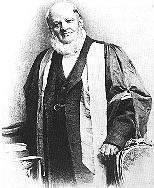Alexander John Ellis
| Alexander John Ellis FRS | |
|---|---|
 | |
| Born |
14 June 1814 Hoxton, Middlesex , England |
| Died |
28 October 1890 (aged 76) Kensington, London, England |
| Nationality | British |
| Education | Shrewsbury School, Eton College |
| Alma mater | Trinity College, Cambridge |
| Occupation | mathematician and philologist |
Alexander John Ellis, FRS (14 June 1814 – 28 October 1890) was an English mathematician and philologist, who also influenced the field of musicology. He changed his name from his father's name Sharpe to his mother's maiden name Ellis in 1825, as a condition of receiving significant financial support from a relative on his mother's side.[1] He is buried in Kensal Green Cemetery, London.
Biography
He was born Alexander John Sharpe in Hoxton, Middlesex to a wealthy family. His father James Birch Sharpe was a notable artist and physician, who was later appointed Esquire of Windlesham. His mother Ann Ellis was from a noble background, but it is not known how her family made its fortune. Alexander's brother James Birch Sharpe junior, died at the Battle of Inkerman, during the Crimean War. His other brother William Henry Sharpe served with the Lancashire Fusiliers after moving north with his family to Cumberland, due to military work.
Alexander was educated at Shrewsbury School, Eton College and Trinity College, Cambridge (BA 1837). Initially trained in mathematics and the classics, he became a well-known phonetician of his time. Through his work in phonetics, he also became interested in vocal pitch and by extension, in musical pitch as well as speech and song.
Ellis is noted for translating and extensively annotating Hermann von Helmholtz's On the Sensations of Tone. The second edition of this translation, published in 1885, contains an appendix which summarises Ellis' own work on related matters.
In his writings on musical pitch and scales,[2] Ellis elaborates his notion and notation of cents for musical intervals. This concept became especially influential in Comparative musicology, a predecessor of ethnomusicology. Analyzing the scales (tone systems) of various European musical traditions, Ellis also showed that the diversity of tone systems cannot be explained by a single physical law, as had been argued by earlier scholars.
In part V of his work On Early English Pronunciation, he applied the Dialect Test across Britain. He distinguished forty-two different dialects in England and the Scottish Lowlands.[3]
He was acknowledged by George Bernard Shaw as the prototype of Professor Henry Higgins of Pygmalion (adapted as the musical My Fair Lady).[4] He was elected in June 1864 as a Fellow of the Royal Society.[5]
Ellis's son Tristram James Ellis trained as an engineer, but later became a noted painter of the Middle East.[6]
Phonetic alphabets
Ellis developed two phonetic alphabets, phonotype, which used many new letters, and palæotype, which replaced many of these with turned letters (such as ⟨ə⟩, ⟨ɔ⟩), small caps (such as ⟨ɪ⟩), and italics. Two of his novel letters survived: ⟨ʃ⟩ and ⟨ʒ⟩ were passed on to Sweet's Romic alphabet and from there to the International Phonetic Alphabet.
Works (selected)
- 1845, The Alphabet of Nature
- 1848, A Plea for Phonetic Spelling: or, The Necessity of Orthographic Reform
- 1869, On Early English Pronunciation, London: N. Trübner / reissued by Greenwood Press: New York (1968).
- --do.-- On early English pronunciation : with especial reference to Shakspere and Chaucer, containing an investigation of the correspondence of writing with speech in England from the Anglosaxon period to the present day ... (text online at «archive.org»)
- 1885, "On the Musical Scales of Various Nations", Journal of the Society of Arts 33, p. 485. (Link is to a HTML transcription (Accessed September 2008)
- 1890, English Dialects – Their Sounds and Homes
Notes
- ↑ John Hannavy (2008). Encyclopedia of Nineteenth-Century Photography. CRC Press. ISBN 0-415-97235-3.
- ↑ Journal of the Society of Arts, Vol. 28, p. 295
- ↑ An Atlas of Alexander J. Ellis's The Existing Phonology of English Dialects, http://www.lel.ed.ac.uk/EllisAtlas/Index.html, has further details.
- ↑ Ross Duffin, How Equal Temperament Ruined Harmony, W.W. Norton and Co., 2007
- ↑ "Library and Archive catalogue". Royal Society. Retrieved 30 November 2010.
- ↑ Black, Helen C. (1896), Pen, pencil, baton and mask: biographical sketches, Spottiswoode, pp. 345–351
References
 Chisholm, Hugh, ed. (1911). "Ellis, Alexander John". Encyclopædia Britannica (11th ed.). Cambridge University Press.
Chisholm, Hugh, ed. (1911). "Ellis, Alexander John". Encyclopædia Britannica (11th ed.). Cambridge University Press. Carlyle, Edward Irving (1901). "Ellis, Alexander John". In Sidney Lee. Dictionary of National Biography, 1901 supplement. London: Smith, Elder & Co.
Carlyle, Edward Irving (1901). "Ellis, Alexander John". In Sidney Lee. Dictionary of National Biography, 1901 supplement. London: Smith, Elder & Co. - M. K. C. MacMahon, Ellis , Alexander John (1814–1890), Oxford Dictionary of National Biography, Oxford University Press, 2004 accessed 14 June 2006
External links
- Works by or about Alexander John Ellis at Internet Archive
- Works by Alexander John Ellis at LibriVox (public domain audiobooks)
